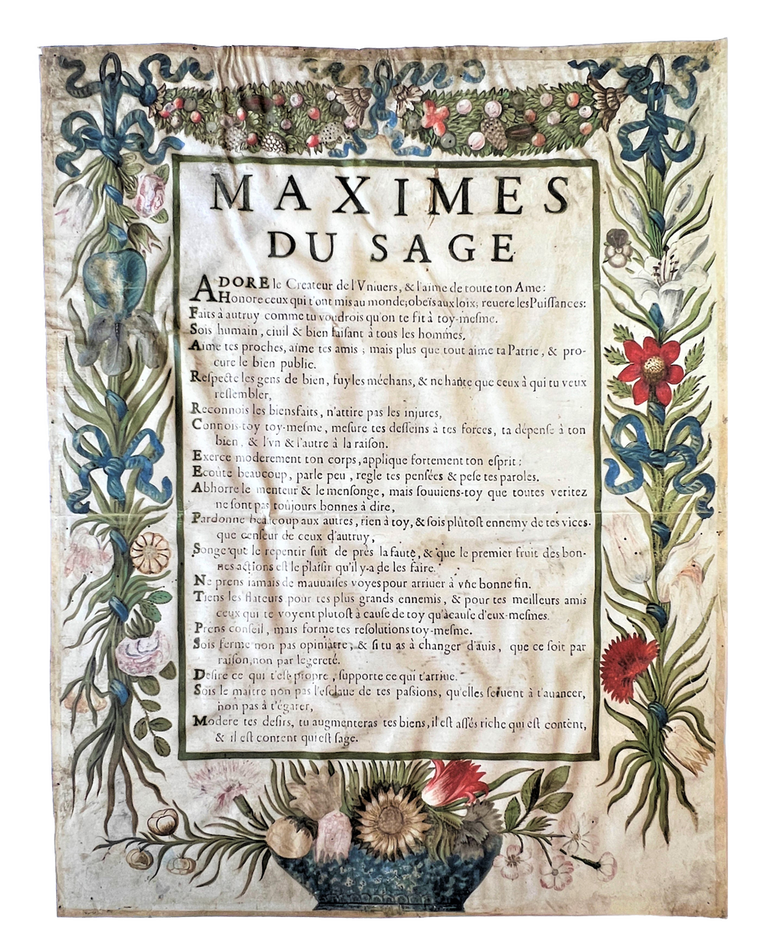Maximes du Sage. [France, ca. 1670-1700].
Large typographic and painted broadside on vellum (530 x 415 mm.) Text in 30 lines in a Petit Canon Roman type, title in two lines in large capitals, 2-line initial capital; title, initial capital, first word of first verse and first letters of the other verses printed in dark green; text within a narrow green frame, set within a large and fine original gouache floral border: flowering stems tied with blue ribbon at sides, two garlands at top, and a flower-filled china bowl at bottom. Pinholes at top corners. A few small wormholes, some wrinkling to vellum, occasional rubbing to small areas of border, some marginal dust-soiling, soiling to blank verso. ***
An unrecorded broadside of moral maxims for the young, printed on vellum and illuminated, most likely for a princely or aristocratic household or educational establishment. Printed in a large, clear Roman typeface (see below) on a very large sheet of vellum, surrounded by a lavish border of realistic painted flowers and garlands, this list of wise counsels, addressing as yet unformed youth, was meant to be hung on the wall for contemplation. In the late 17th century some print publishers issued engraved broadsides with religious-moral exhortations, intended to be hung in the corridors and refectories of religious schools; this may be a particularly luxurious incarnation of that genre.
The precepts counsel self-knowledge, self-control, honesty, vigilance combined with discretion (”Ecoute beaucoup, parle peu, regle tes pensées & pese tes paroles”), moderation, tolerance toward others and high standards for oneself, respect for one’s elders and established authority, love of the Patrie, the avoidance of bad means to arrive at a good end, distrust of flatterers, and acceptance of one’s fate. The use of the familiar tu form shows that a child or youth was addressed. In its overall tone, and in lines such as “procure le bien public” (procure the public good), this list of maxims appears to fit the paradigm of traditional advice to princes.
The text begins: “Adore le Createur de l'Vnivers, & l’aïme de toute ton Ame: / Honore ceux qui t’ont mis au monde; obeïs aux loix; reuere les Puissances: / Faits à autruy comme tu voudrois qu’on te fit à toy-mesme. / Sois humain, ciuil & bien faisant à tous les hommes, / Aime tes proches, aime tes amis; mais plus que tout aime ta Patrie, & pro-/ cure le bien public.” ...
The text typeface, rather worn, is Granjon’s Two-line English Roman (R 190) or Petit Canon (Vervliet Conspectus 140). The title capitals measure 22 mm. (line 1) and 17 mm. (line 2). Robert Granjon, one of the most productive and talented of 16th-century French type designers and typefounders, produced dozens of types between 1540 and 1590, which remained in circulation for over 200 years. “Printing types from his matrices were available in France, Italy, Spain, the Netherlands, and the German-speaking and Scandinavian countries through the normal trade until the end of the eighteenth century” (Vervliet, p. 44). It is thus not surprising to find one of Granjon’s handsome Roman typefaces on a broadside from the seventeenth century. The printer is unknown, and it is likely that the broadside may have been privately printed. Printing on vellum was not easy, but it is thanks to its support that this copy was preserved. There may have been other copies, but I locate none in OCLC, the BnF, or the Catalogue collectif de France (with the caveat that broadsides were often traditionally omitted from library catalogues).
The fine gouache border of this exceptional ephemeral survival includes several types of flowers, including lilies, carnations, an iris, tulips, and pansies. The swags at top contain stylized acorns and berries. The style and conception of the painting show the influence of the illuminated manuscripts produced by the calligrapher Nicolas Jarry (1620-1670), and by the “Atelier des Vélins du roi,” a workshop of artist-veterans residing in the Invalides, who produced natural history watercolors on vellum, liturgical and other devotional books, and even fan leaves, for King Louis XIV as well as other prominent patrons.
A similar set of maxims, without the title, appeared in a manuscript on vellum, possibly commissioned by Louis XIV for his son Louis, the Grand Dauphin (1661-1711), sold at Christie’s New York, 23 October 1998, lot 18 and again at Sotheby’s Paris, 6 July 2017, lot 28. The wording of the maxims is not identical throughout, but is very similar, and follows the same order. The illumination of that manuscript, comprising a picture of Louis XIV and the Dauphin, and the royal monogram, was tentatively attributed to the Atelier des Vélins du roi.
Cf. H. Vervliet, French Renaissance Printing Types: a Conspectus (2010). Item #4191
No longer available


